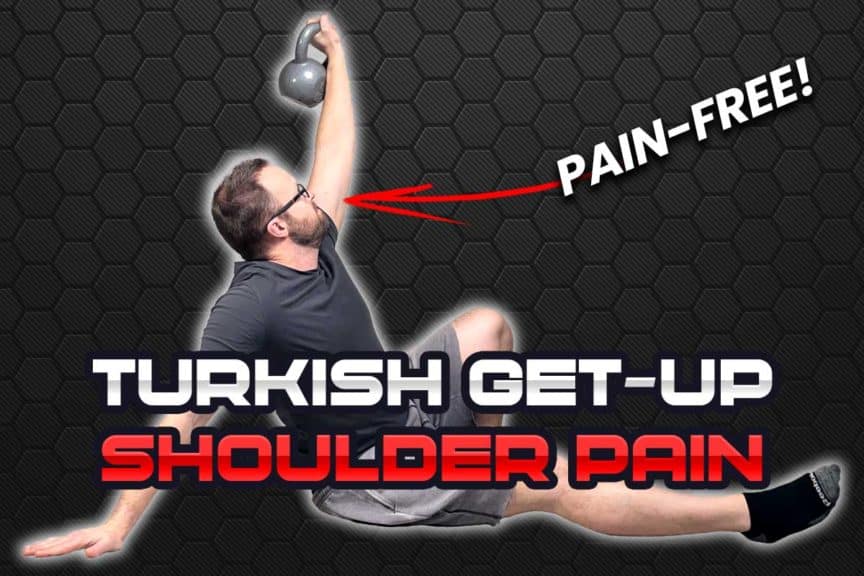Few exercises challenge the entire body in one single repetition the way that the Turkish get-up (TGU) does. However, due to its incredibly technical nature, it’s not uncommon for shoulder pain to arise throughout the movement. There are many reasons why this can happen, and this article will break it all down to help you understand, fix or avoid shoulder pain when performing this unrivalled exercise.
To fix shoulder pain from the Turkish get-up, you must ensure your shoulder has adequate mobility and strength for the movement while also using pristine mechanics throughout the entire exercise. You must also use a load that is appropriate for your shoulder and the rest of your body.
Of course, that is the quick answer packed into a couple of sentences. If you want to learn the specifics for the step-by-step actions to take, along with how to ensure you’re correcting the underlying issue entirely, be sure to keep on reading!
ARTICLE OVERVIEW (Quick Links)
Click/tap the article headlines below to instantly jump to that section!
• Pain-free TGU shoulder requirements
• Pain generators of the shoulder
• Common movement errors causing pain
• Bonus tip: Use THIS to master perfect form
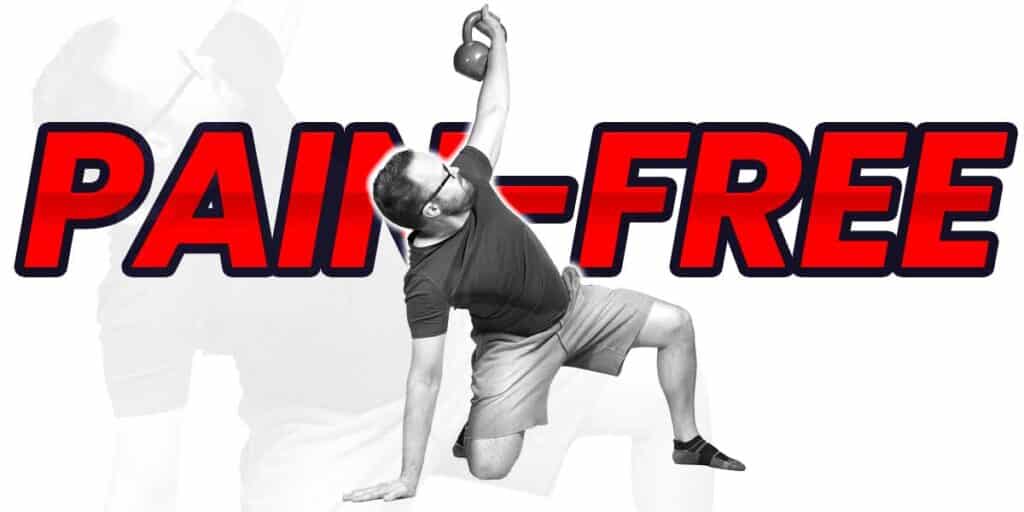
Pain-free TGU shoulder requirements
There are a few critical factors at play when it comes to ensuring happy shoulders when performing your Turkish get-ups. For any exercise, you must ensure that you have the ability to achieve the appropriate amount of each of the three factors:
- Joint mobility of the joint(s)
- Joint stability of the joint(s)
- Movement/motor control around the joint
The Turkish get-up is no different. Let’s look at these three factors in a bit more detail:
1. Joint mobility (range of motion)
The TGU requires the shoulder joint (the glenohumeral joint) to undergo and then hold a specific range of movement. Normal range of motion for shoulder flexion (the movement involving raising your arm above your head) is 180 degrees (i.e. holding your arm perfectly vertical above your head).1 If you can take your arm from your side to straight up above your head, that’s 180 degrees of flexion. And you need every bit of that range to maintain optimal shoulder health on this exercise.
If your shoulder can’t produce and hold this range of motion (which can happen for various reasons), performing the TGU can then produce excessive strain on muscles, cause shoulder impingement or stress restricted capsular tissue — all of which can cause pain or lead to injury. These are all discussed further below if you want to learn the specifics of each.
Pro tip: If you can raise your arm vertically above your head while standing or sitting but have trouble keeping it vertically above your head at any point during the TGU, it likely signifies that you are lacking adequate mobility elsewhere in the body during certain phases of the movement.
2. Adequate strength & stability for load
With the shoulder joint being classified as a ball and socket joint, it can produce significant ranges of motion. However, the more mobile a joint is, the greater the inherent stability it must sacrifice in return.
If your shoulder joint has excessive instability (which can occur for various reasons), or you lack the muscular strength required to produce and control stability around the joint, this could become problematic; the TGU can produce excessive translation or shifting of the joint enough to the point that muscles, the labrum or the subacromial bursa can become irritated, resulting in pain or discomfort.
Pro tip: The healthier and stronger a muscle is, the more effectively it can produce stability of the joint that it crosses.
3. Proper positioning & motor control
In addition to the need to have an adequate range of motion (mobility) AND stability of the shoulder joint, you MUST have the ability to control the movement of your shoulder throughout the entire duration of the TGU. The ability to volitionally and properly control movement is known as motor control.
You can have all the strength and mobility in the world, but if you can’t then control these parameters, the exercise can quickly go awry in several different ways, which can create shoulder dysfunction, pain and even injury.
Having adequate strength and range of motion but then lacking control over how you move is like having a high-end sports car that has a super powerful engine and is very aerodynamic, but you lack the ability to steer and control it as you drive. It’s a recipe for disaster.
To learn how to ensure you have adequate motor control of your shoulder joint while performing the TGU, you’ll want to check out the bonus tip at the end of this article. It has cleaned up the movement errors on numerous patients and clients I’ve worked with who have needed to master their movement control with the TGU.
Pain generators of the shoulder
Numerous pain-generators exist in and around the shoulder joint, and there are various reasons for pain to occur. What follows is only a list of the more common culprits (it is not exclusive) that I tend to see in the clinic when it comes to rehabbing shoulders that become painful when performing Turkish get-ups or similarly-demanding exercises.
Rotator cuff (straining)
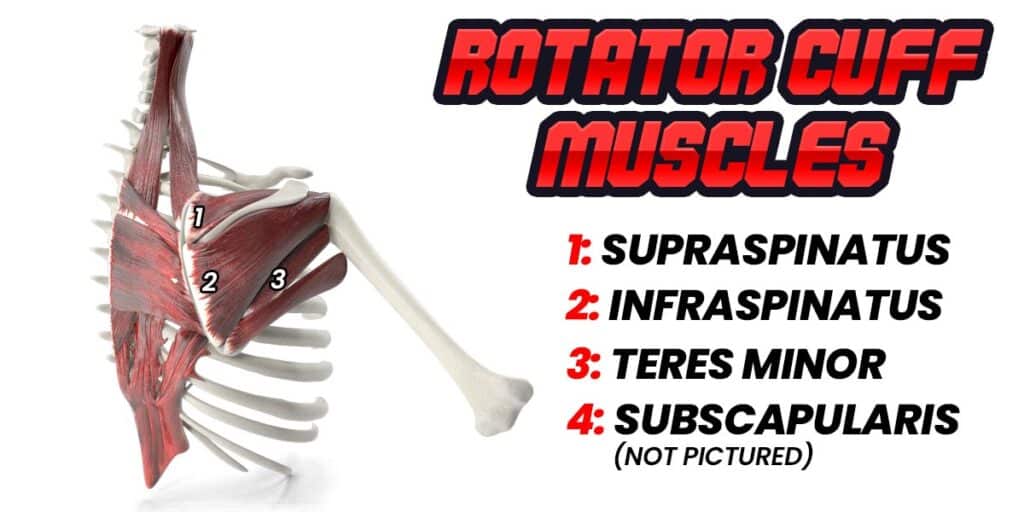
The rotator cuff complex is a series of four small muscles that cross the shoulder joint. Their job is to fine-tune any shoulder movements that we produce as we take our shoulder from point A to point B.
They are NOT the powerhouse muscles of the shoulder that produce shoulder movement — they just fine-tune it. Powerhouse muscles that move the shoulders are muscles such as the pectorals, the latissimus dorsi and the deltoid muscles.
Related article: Strengthening Your Infraspinatus with a Dumbbell (3 Proven Exercises)
As a result, excessive demand can run through these delicate rotator cuff muscles if they have to work to hold the arm in a less-than-vertical position. And if you already have an unhealthy rotator cuff muscle (rotator cuff tendinopathy, a small/partial tear, etc.), you could be causing much unnecessary strain and irritation to any of the rotator cuff muscles.
Capsular restriction
If you feel like your shoulder just sort of “hits a wall” when it comes to not wanting to move past a specific range of shoulder flexion (lifting the arm overhead), it could be the result of restriction coming from the joint capsule, which covers the ball and socket joint.
The joint capsule is a sort of leather bag that wraps around the joint and encases it. The shoulder capsule is notorious for becoming stiff and fibrotic, especially for individuals in their third, fourth and fifth decade of life.2
A stiff joint capsule is often known as adhesive capsulitis, or more commonly referred to as a frozen shoulder. Shoulder capsules can become stiff and fibrotic (immobile) after an injury or for no reason at all (known as an idiopathic onset).2
Sometimes shoulder capsules become stiff without producing much pain, and other times they can be very painful in addition to being stiff. Regardless of which camp you fall into, you will likely notice that you physically can’t achieve a full range of motion in your shoulder if the capsule is stiff.
If you know that your capsule is the culprit in causing your shoulder pain with the TGU, learning to stretch the capsule is likely your best bet. It can take a lot of effort and time to get a shoulder capsule back to its normal functioning state. Still, it’s often doable with a committed capsule mobility routine and time to go along with it.
Subacromial impingement
Impingement refers to the pinching of a tissue, which can often produce irritation and pain. In the case of the shoulder, shoulder impingement results from the humerus (upper arm bone) slamming into the roof of the shoulder blade (the roof is known as the acromion).
When this slamming of the two bony surfaces occurs (which can happen when the arm is raised above the head), one of the rotator cuff muscles (the supraspinatus muscle) is prone to getting pinched between each bone.
A second structure that can become irritated is the subacromial bursa. This little water balloon-like disc normally helps decrease friction between tendons and bones interfacing with each other. When a bursa becomes irritated and inflamed, the condition is known as bursitis. It can produce noticeable discomfort within the shoulder, which is particularly most noticeable when attempting to raise the arm above 90 degrees of flexion or abduction.
Lousy neck mobility
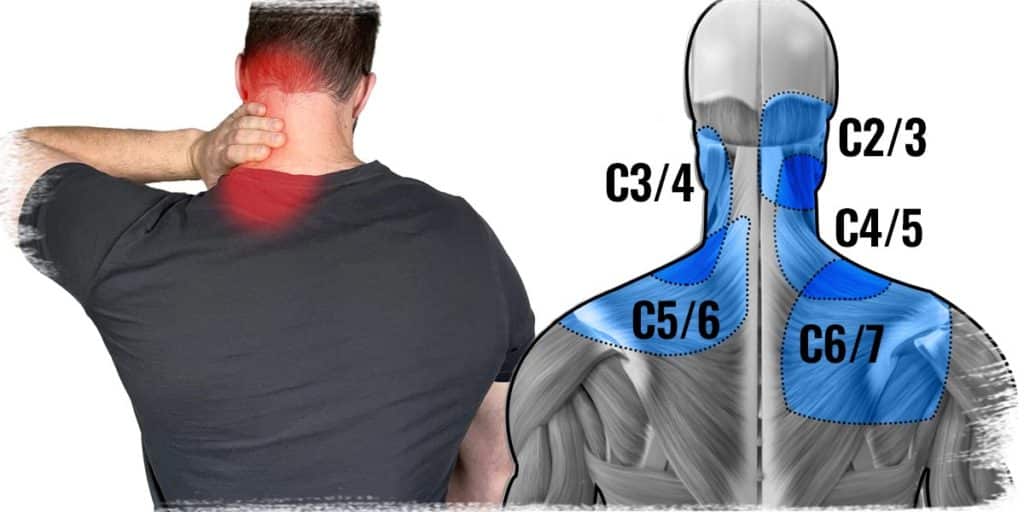
While the neck and shoulder are anatomically two different parts of the body, from a functional perspective, they are heavily intertwined. As a result, lousy shoulder health can lead to all sorts of cervical (neck) dysfunction and vice versa.
This is critical to understand, as irritation or dysfunction in the neck can actually refer the pain to the shoulder region. This is the phenomenon of referred pain, which occurs when the pain is somatic in nature (meaning that the pain generator is coming from a muscle, tendon or bone).
Related article: The BEST Way to Stretch Your Stiff Upper Neck: A Physio Explains
The most common reason for neck dysfunction to refer pain into the shoulder is due to irritation of the facet joints of the spine. Facet joints are the articulating surfaces of one vertebra to another. In short, they are what permit our spine to move.
When these joints become stiff, arthritic or dysfunctional in any other capacity, they refer their pain to rather specific regions of the shoulder. Take a look at the image below to visually understand the mapping of cervical joint dysfunction to corresponding regions of shoulder pain.
This phenomenon is known as facetogenic referral patterns, and they are extensively studied and universal within humans.3
Now, think about the positions you have to twist, move and hold your neck while going through the Turkish get-up. There is a lot of cervical rotation and extension required from the facet joints within your neck. If your joints can’t tolerate certain ranges, positions, or both, then the joint can become irritated and refer pain to your shoulder.
So, if you suspect your neck may be the culprit, or at least contributing to your shoulder pain, get it checked out and do what you can to get your neck mobility (and strength) under control.
Too much load
It may sound obvious, but using a weight that is too heavy for your shoulder to tolerate or for you to adequately control can lead to shoulder discomfort.
The heavier the weight you use for the Turkish get-up, the more pristine your form and technique have to be, especially around the shoulder joint.
Heavy weight reduces the “buffer” you have for getting away with less-than-ideal technique. It can become incredibly easy to strain rotator cuff muscles or lose control of your shoulder positioning with near-maximal weight as heavy weight tends to control you rather than the other way around.
As a result, backing off on the weight and performing the movement with pristine mechanics will likely yield superior results when it comes to getting you stronger, optimizing your movement and avoiding pain in the process.
Pro tip: If you want to challenge yourself on the Turkish get-up while using less weight, perform the entire movement going only half as fast as you would otherwise go. Slow Turkish get-ups can be agonizingly fatiguing and challenging while allowing you to keep your shoulder in safe positions and from excessive strain.
Common movement errors
Of all the movement errors that can take place with the shoulder throughout the Turkish get-up, the two most common pain-provoking errors are a failure to keep the arm vertical at all times and inadequate upwards rotation of the scapula (shoulder).
Let’s look at these in more detail to help you understand how to avoid or correct these issues (your shoulder will thank you).
Failure to keep arm vertical at all times

As mentioned earlier, failing to keep your arm perfectly upright throughout the entirety of the Turkish get-up will lead to all sorts of excessive strain of the musculature around your shoulder — notably the rotator cuff muscles.
The less vertical your arm is throughout the movement, the greater the strain on your shoulder. And the heavier the weight in your hand, the greater the potential for there to be strain on your shoulder.
As a result, the worst possible scenario here is to fail to keep your arm vertical even for a split second when using a heavier weight. Plus, the heavier you go, the harder it will be to maintain proper scapulohumeral positioning with your arm above your head (see next section).4
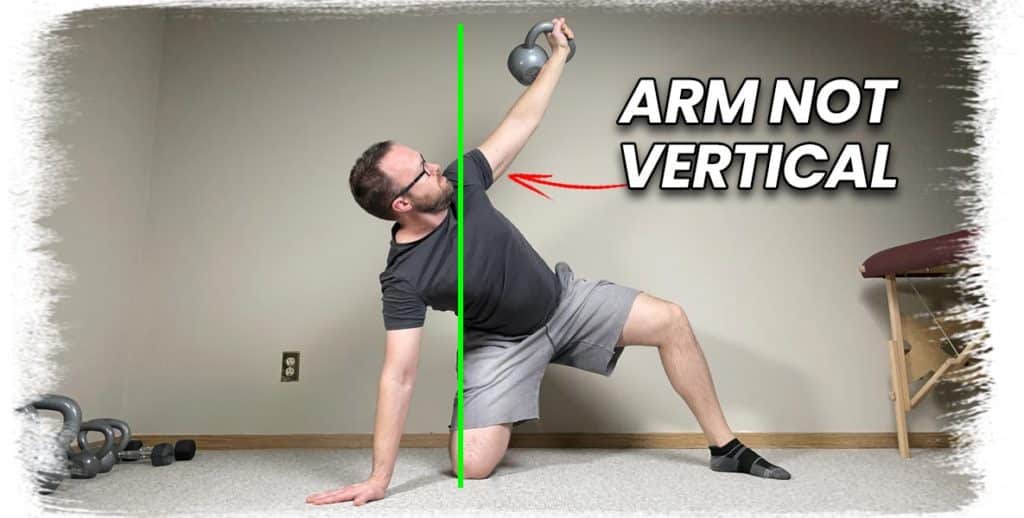
The solution here is to let go of your ego and use a lighter weight that you can perfectly control. Having pain-free, healthy shoulders is far more important than bragging to your friends how heavy of a TGU you did while simultaneously dealing with shoulder pain in the aftermath. At least, it is in my humble opinion.
Inadequate upwards rotation of the scapula
When raising your arm above your head (either raising to the front or raising to the side), your shoulder blade needs to move upwards in addition to your arm bone.
Not everyone is aware of this, but the fact of the matter is that if you only move your arm upwards and not your shoulder blade as well, you’re at much greater risk of developing shoulder impingement (that condition where you pinch or irritate specific tissues by slamming them between the upper arm bone and the roof of the shoulder blade.
To avoid this, you need to have the appropriate ratio of movement between your arm bone and your scapula (shoulder blade). This is known as scapulohumeral rhythm. Take a look at the video below to see what this looks like:
As you’ll notice in the video, the upward rotation of the shoulder blade ensures that the arm bone doesn’t slam into the acromion (roof of the shoulder blade). When this space is maintained, there is no pinching of the supraspinatus muscle or the subacromial bursa.
So, make sure that you are keeping your shoulder blade rotated upwards at all times when your arm is above your head. Basically, think of trying to push your fist up towards the ceiling as high as possible when your arm is above your head. It may take a bit of effort or feel a bit unusual, but your shoulder will thank you.
Bonus tip: Use THIS to master perfect form
As stated a few times within this article, your arm positioning and movement control need to be pristine throughout the TGU, assuming you want to ensure pain-free shoulders for some time to come.
The best way to determine if you can achieve proper shoulder positioning while holding it in the proper position throughout the entirety of the movement is to complete an entire repetition (up AND down) while balancing your shoe on your knuckles.
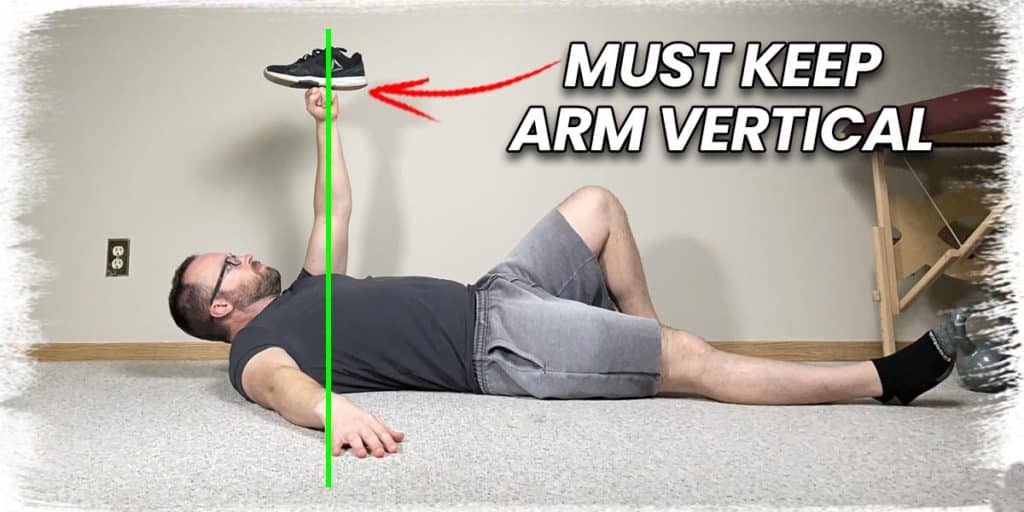
To do this, simply lay on the ground in the starting position for the TGU, make a fist and balance the sole of your shoes across them.
If at any point you fail to keep your arm vertical, or you can’t control the positioning of your shoulder, your shoe will fall off, letting you know that you’ve failed to maintain adequate movement and positioning of your shoulder.
A shoe works quite well for this since it’s easy to find one to use, and it won’t hurt you if it falls off and lands on any other portion of your body.
Once you can consistently and confidently complete this task, you can rest assured that you’re likely keeping your shoulder healthy and happy when using weights instead of a shoe.
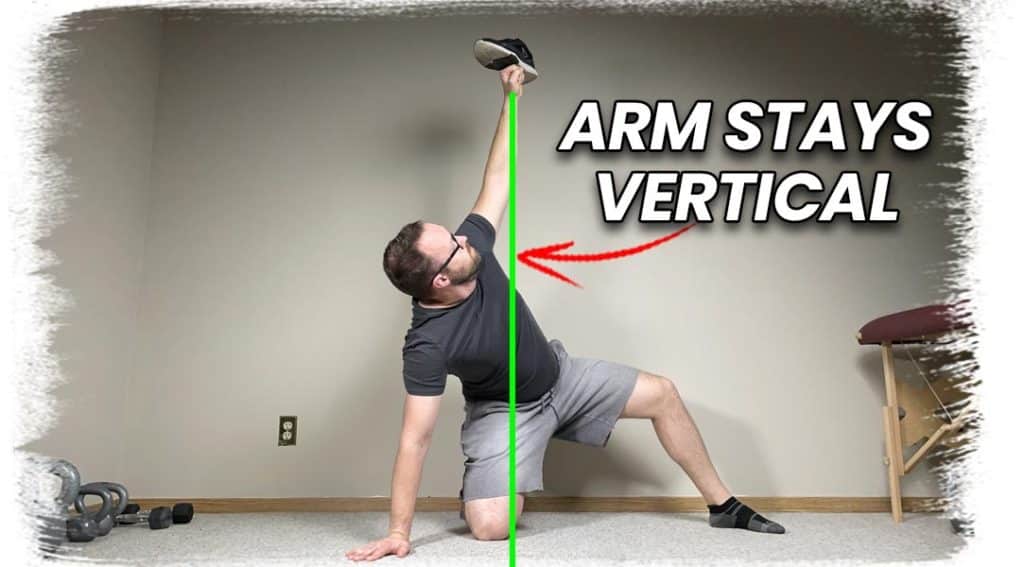
Consider this an insurance policy when it comes to keeping pain from coming anywhere near your shoulders when attempting to perform the Turkish get-up.
Final thoughts
When it comes to pain and injury, prevention is better than ANY cure. But if you already have some pain, you need to abide by rule number two: never let a little bit of pain become major amounts of pain.
If your shoulders are currently feeling pretty good, take the time required to ensure that your shoulder range of motion, stability and movement control are all top-notch when performing your Turkish get-ups.
If your shoulders seem to complain during or after this exercise, take the time to determine where the limitation or fault may lie. It can be a bit frustrating to do, but you will reap significant rewards in terms of ensuring longevity in your training as opposed to simply trying to push through the pain.
References:
1. Gill TK, Shanahan EM, Tucker GR, Buchbinder R, Hill CL. Shoulder range of movement in the general population: age and gender stratified normative data using a community-based cohort. BMC Musculoskelet Disord. 2020;21(1):1-9.
2. Manske RC, Prohaska D. Diagnosis and management of adhesive capsulitis. Curr Rev Musculoskelet Med. 2008;1(3):180-189.
3. Windsor RE, Nagula D, Storm S, Overton A, Jahnke S. Electrical stimulation induced cervical medial branch referral patterns. Pain Physician. 2003;6(4):411-418.
4. McQuade KJ, Dawson J, Smidt GL. Scapulothoracic muscle fatigue associated with alterations in scapulohumeral rhythm kinematics during maximum resistive shoulder elevation. J Orthop Sports Phys Ther. 1998;28(2):74-80.

Hi! I’m Jim Wittstrom, PT, DPT, CSCS, Pn1.
I am a physical therapist who is passionate about all things pertaining to strength & conditioning, human movement, injury prevention and rehabilitation. I created StrengthResurgence.com in order to help others become stronger and healthier. I also love helping aspiring students and therapists fulfill their dreams of becoming successful in school and within their clinical PT practice. Thanks for checking out my site!

